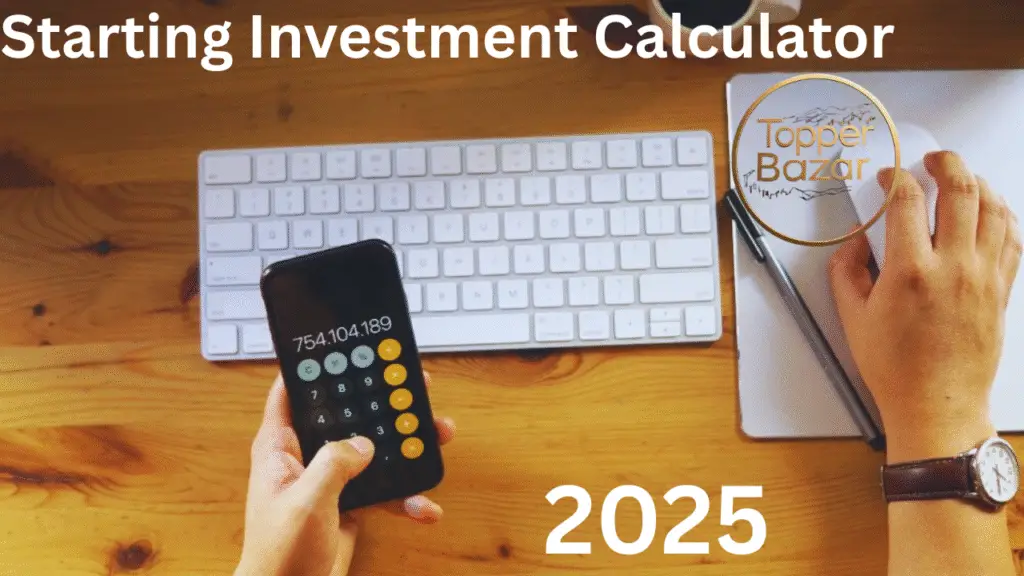Starting Investment Calculator
A Starting Investment Calculator is a valuable tool for anyone eager to begin their personal finance and investing journey. It helps you estimate how much money you need to start investing, how your investments might grow, and what you can achieve with your savings over time. By simplifying complex calculations, this tool empowers beginners and seasoned investors alike to make informed decisions. This article explains what a starting investment calculator is, how it works, its benefits, and practical tips to kickstart your investment plan while staying aligned with your financial goals.

What is a Starting Investment Calculator?
A starting investment calculator is an online tool that projects how an initial investment can grow based on factors like the amount you invest, expected returns, and time horizon. It also helps determine how much you need to start investing to reach specific goals, like saving for a car or retirement. Available on financial websites like NerdWallet, Bankrate, or investment platforms like Vanguard, these calculators use compound interest formulas to estimate future value, making it easier to plan your financial future.
Real-World Impact
Web sources highlight success stories. A Reddit user used a starting investment calculator to plan $100 monthly contributions to an S&P 500 fund, growing $6,000 to $10,000 in 5 years at 8%. Another, via NerdWallet, started with $500 in an ETF, adding $50 monthly, reaching $5,000 in 7 years. These show how calculators guide realistic plans, turning small investments into significant wealth.
Starting Investment Calculator and Personal Finance

A starting investment calculator supports personal finance by showing how small, consistent investments grow over time, aligning with goals like retirement or debt freedom. For example, saving $50 monthly from a reduced grocery bill and investing at 7% could yield $17,000 in 10 years, funding an emergency fund or Roth IRA. This discipline mirrors investing principles, prioritizing long-term growth over short-term spending.
Steps to Use a Starting Investment Calculator Effectively
- Choose a Reliable Tool: Use calculators from trusted sources like Bankrate, Fidelity, or Omni Calculator. Avoid tools requiring excessive personal data.
- Gather Financial Data: Know your income, expenses, and available cash for investing. Check your budget to find $25–$100 monthly.
- Set Clear Goals: Define what you’re investing for—retirement, a house, or education—and your timeline (e.g., 5 or 20 years).
- Input Realistic Data: Enter accurate amounts and conservative return rates (e.g., 6–8% for stocks, 3–4% for bonds) to avoid overestimating.
- Test Scenarios: Try different starting amounts or contribution levels. For example, compare $500 vs. $1,000 initial investments or $50 vs. $100 monthly additions.
- Review Regularly: Update the calculator yearly or after life changes (e.g., a raise) to keep your plan on track.
Benefits of a Starting Investment Calculator

- Clarity: Shows exactly how much you need to start and how it grows, like $200 monthly growing to $34,000 in 10 years at 7%.
- Accessibility: Helps beginners start with small amounts, like $50, using platforms like Acorns or Stash.
- Time Value: Highlights the benefit of starting early—$1,000 at 7% for 20 years grows to $3,870, but only $1,811 in 10 years.
- Goal Planning: Aligns investments with goals, ensuring you save enough for a $20,000 goal in 5 years.
- Risk Assessment: Tests low-risk (bonds) vs. high-risk (stocks) options to match your comfort level.
Tips to Maximize Your Investment Plan
- Start Small: Platforms like Robinhood or Wealthfront allow investments as low as $10. A calculator can show $10 monthly growing to $2,000 in 20 years at 6% Starting Investment Calculator.
- Automate Contributions: Set up automatic transfers to brokerage accounts to stay consistent.
- Choose Low-Cost Investments: Opt for index funds or ETFs with fees under 0.5%, like Vanguard’s VTI, to maximize returns.
- Diversify: Spread investments across stocks, bonds, or REITs to reduce risk, as calculators can model.
- Pair with Budgeting: Use a grocery bill calculator to cut expenses, freeing up $50–$100 monthly for investing.
- Learn More: Read The Simple Path to Wealth by JL Collins for investing basics to complement calculator insights.
Conclusion

A Starting Investment Calculator is a must-have for anyone beginning their personal finance and investing journey. It simplifies planning, shows growth potential, and aligns investments with your goals. By starting small, automating contributions, and using trusted tools, you can turn modest sums into substantial wealth. Try a calculator today, set your goals, and take the first step toward a secure financial future.




